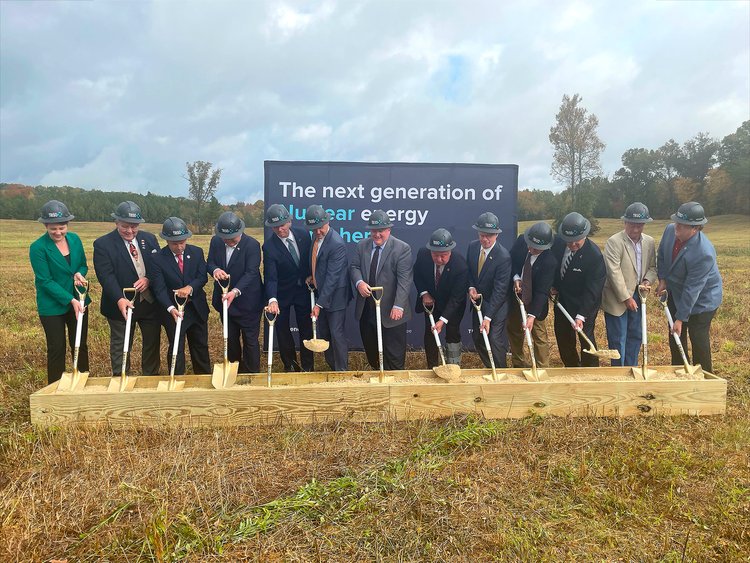Virginia Gov. Glenn Youngkin announces a $10 million energy innovation investment in Virginia. (Photo: Christian Martinez/Office of the Governor)
Some two weeks after unveiling his state’s 2022 Energy Plan, Virginia Gov. Glenn Youngkin has announced his intention to include $10 million in the state’s next budget proposal—due in December—to create the Virginia Power Innovation Fund for research and development of nuclear, hydrogen, carbon capture and utilization, and battery storage technologies.
Government officials and representatives of X-energy and its TRISO-X subsidiary at the October 13 groundbreaking. (Photo: X-energy)
Leaders of X-energy and its TRISO-X subsidiary gathered on October 13 to break ground at the site of what X-energy bills as “North America’s first commercial-scale advanced nuclear fuel facility” in Oak Ridge, Tenn. X-energy expects the TRISO-X Fuel Fabrication Facility (TF3) to create more than 400 jobs and to be commissioned and operational by 2025.
Caption. (All photos: Duke Energy)
Duke Energy’s Harris nuclear power plant’s 24th refueling outage began in early October. The plant, located in New Hill, N.C., is a 964-MWe Westinghouse three-loop pressurized water reactor that started commercial operation in May 1987.
Vogtle Unit 3 in September. (Photo: Georgia Power)
Georgia Power announced this morning that fuel loading at Vogtle-3 has commenced, marking an important milestone on what has proved to be a long and bumpy road to startup and commercial operation of the first new nuclear power reactors to be built in the United States in more than three decades. (Major work on the Vogtle-3 and -4 project began in 2012, with a price tag of $14 billion and scheduled unit start dates of 2016 and 2017. The project’s total cost is now expected to exceed $30 billion.)
From left: Czech Republic deputy minister of industry and trade Petr Třešňák, ČEZ’s Tomáš Pleskač, OPG’s Ken Hartwick, Ontario minister of energy Todd Smith, and Canadian ambassador to the Czech Republic Ayesha Patricia Rekhi. (Photo: CNW Group/Ontario Power Generation)
Canada’s Ontario Power Generation (OPG) and Czech Republic–based ČEZ have agreed to collaborate on nuclear technology deployment, including small modular reactors, under a memorandum of understanding signed yesterday in Prague.
Ontario’s largest electricity generator and the European energy giant have both pledged to achieve net-zero carbon emissions by 2040.
G. Robert Keepin, of Los Alamos Scientific Laboratory, author of a three-part feature on the IAEA published in Nuclear News in January, February, and March of 1966; the cover of the January 1966 issue, featuring the IAEA’s first headquarters in the Grand Hotel of Vienna, Austria; and a February 1966 IAEA photo of remote handling of radioisotope standard sources at the Seibersdorf laboratory.
A groundbreaking ceremony held last week at the International Atomic Energy Agency’s laboratories in Seibersdorf, Austria, marked the start of construction on a nuclear applications building that will host three state-of-the-art laboratories: Plant Breeding and Genetics, Terrestrial Environment and Radiochemistry, and Nuclear Science and Instrumentation.It was a significant achievement for the second phase of the Renovation of the Nuclear Applications Laboratories initiative, known as ReNuAL2—and a fitting way to observe the 60th anniversary of the nuclear applications laboratories at Seibersdorf, about an hour’s drive south the IAEA’s headquarters in Vienna. For Nuclear Newswire, it was all the reason we needed to dig into the Nuclear News archives and explore the bygone days of research at the IAEA.
An aerial view of ORNL’s main campus. (Photo: ORNL)
The Gateway for Accelerated Innovation in Nuclear (GAIN) announced the three recipients of its fourth and final round of 2022 vouchers on October 10. The vouchers were awarded to Curio Solutions, which is developing a spent fuel recycling process, and to two companies that are separately investigating advanced reactor siting—Elementl Power and the Tennessee Valley Authority (TVA). The funds for each award will go directly to Oak Ridge National Laboratory.
Cameco headquarters in Saskatoon, Saskatchewan, Canada. (Photo: Cameco)
Five years after bankruptcy, Pennsylvania-based Westinghouse is being sold again, this time with a 49 percent share going to Cameco Corp., the front-end uranium mining, milling, and conversion company headquartered in Saskatchewan, Canada. Cameco and Brookfield Business Partners, based in Toronto, Ontario, announced the deal yesterday. Once it closes as expected, in the second half of 2023, Brookfield Renewable Partners and other Brookfield institutional partners will own a 51 percent interest in a consortium with Cameco.
The Trawsfynydd site in North Wales. (Photo: Magnox Ltd.)
The United Kingdom’s Nuclear Decommissioning Authority (NDA) has announced the signing of a memorandum of understanding with Cwmni Egino to support the development of a small-scale nuclear project in North Wales.
The Spherical Tokamak for Energy Production, shown here in an artist's rendition, is a government-backed prototype fusion energy plant planned for operation in the U.K. in the early 2040s. (Image: UKAEA)
The U.K. Atomic Energy Authority (UKAEA) and Tokamak Energy announced on October 10 that they signed a framework agreement to collaborate on developing spherical tokamaks for power production. This news is a complement to last week’s announcement from the U.K. government that the West Burton A coal-fired power plant site in Nottinghamshire has been selected as the future home of STEP (Spherical Tokamak for Energy Production), the U.K.’s planned prototype fusion energy plant. The government is providing £220 million (about $250 million) of funding for the first phase of STEP, which will see the UKAEA produce a concept design by 2024.
Artist's rendering of an LFR plant. (Image: Westinghouse)
Westinghouse Electric Company and Ansaldo Nucleare have announced the signing of a cooperation agreement to develop a next-generation nuclear power plant based on lead-cooled fast reactor (LFR) technology.
Wholly owned by Italy’s Ansaldo Energia, Ansaldo Nucleare is involved in the production of high-tech nuclear components; the design and construction of new builds; decommissioning; and advanced research on radwaste management, fusion, fourth-generation plants, and small modular reactors. In addition, the firm played a significant role in the development of such Generation III technologies as Westinghouse’s AP600 and AP1000 reactors.
Under the agreement, Westinghouse and Ansaldo Nucleare will advance a common design to maximize synergies; combine experience in design, testing, and licensing; and align respective partner and supply-chain organizations.
Turkey Point nuclear plant. (Image: FPL)
The Nuclear Regulatory Commission is seeking public comment on the scope of its supplemental environmental impact statement (SEIS) on the subsequent renewed licenses for Turkey Point-3 and -4, twin pressurized water reactors operated by Florida Power & Light (FPL). It’s the second time around for both the NRC and FPL—an SLR environmental scoping process conducted in 2018 already yielded renewed licenses for Turkey Point in December 2019. According to an October 7 NRC press release, “The staff intends to examine the environmental issues the commission determined were not properly evaluated for the subsequent license renewal term, as well as any new information for Turkey Point site–specific issues.”
Energy Harbor’s Beaver Valley plant, located on the Ohio River near Shippingport, Pa. (Photo: Energy Harbor)
Two critical factors for the success of nuclear industry outages are safety and efficiency. This includes personal and nuclear safety for the team members working on the outage, equipment safety through proper inspections and maintenance, and ultimately public safety when a reactor system is returned to service, free of defects and ready for reliable power production.





















